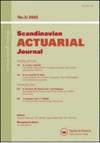Insurance pricing with hierarchically structured data an illustration with a workers' compensation insurance portfolio
IF 1.4
3区 经济学
Q3 MATHEMATICS, INTERDISCIPLINARY APPLICATIONS
引用次数: 1
Abstract
Actuaries use predictive modeling techniques to assess the loss cost on a contract as a function of observable risk characteristics. State-of-the-art statistical and machine learning methods are not well equipped to handle hierarchically structured risk factors with a large number of levels. In this paper, we demonstrate the data-driven construction of an insurance pricing model when hierarchically structured risk factors, contract-specific as well as externally collected risk factors are available. We examine the pricing of a workers' compensation insurance product with a hierarchical credibility model [Jewell, W. S. (1975). The use of collateral data in credibility theory: A hierarchical model. Laxenburg: IIASA], Ohlsson's combination of a generalized linear and a hierarchical credibility model [Ohlsson, E. (2008). Combining generalized linear models and credibility models in practice. Scandinavian Actuarial Journal 2008(4), 301–314] and mixed models. We compare the predictive performance of these models and evaluate the effect of the distributional assumption on the target variable by comparing linear mixed models with Tweedie generalized linear mixed models. For our case-study the Tweedie distribution is well suited to model and predict the loss cost on a contract. Moreover, incorporating contract-specific risk factors in the model improves the predictive performance and the risk differentiation in our workers' compensation insurance portfolio.保险定价与层次结构的数据一个插图与工人赔偿保险投资组合
精算师使用预测建模技术,以可观察到的风险特征为函数来评估合同的损失成本。最先进的统计和机器学习方法无法很好地处理具有大量层次结构的风险因素。在本文中,我们展示了当有层次结构的风险因素、合同特定的风险因素和外部收集的风险因素时,数据驱动的保险定价模型的构建。我们用层次可信度模型研究了工伤赔偿保险产品的定价[Jewell, w.s.(1975)]。信用理论中担保数据的使用:一个层次模型。Laxenburg: IIASA], Ohlsson的广义线性和分层可信度模型的组合[Ohlsson, E.(2008)。将广义线性模型与可信度模型相结合。精算学报,2008(4),301-314]。我们比较了这些模型的预测性能,并通过比较线性混合模型和Tweedie广义线性混合模型来评估分布假设对目标变量的影响。对于我们的案例研究,Tweedie分布非常适合建模和预测合同的损失成本。此外,在模型中加入合同特定风险因素,提高了我国工伤赔偿保险组合的预测性能和风险分化。
本文章由计算机程序翻译,如有差异,请以英文原文为准。
求助全文
约1分钟内获得全文
求助全文
来源期刊

Scandinavian Actuarial Journal
MATHEMATICS, INTERDISCIPLINARY APPLICATIONS-STATISTICS & PROBABILITY
CiteScore
3.30
自引率
11.10%
发文量
38
审稿时长
>12 weeks
期刊介绍:
Scandinavian Actuarial Journal is a journal for actuarial sciences that deals, in theory and application, with mathematical methods for insurance and related matters.
The bounds of actuarial mathematics are determined by the area of application rather than by uniformity of methods and techniques. Therefore, a paper of interest to Scandinavian Actuarial Journal may have its theoretical basis in probability theory, statistics, operations research, numerical analysis, computer science, demography, mathematical economics, or any other area of applied mathematics; the main criterion is that the paper should be of specific relevance to actuarial applications.
 求助内容:
求助内容: 应助结果提醒方式:
应助结果提醒方式:


